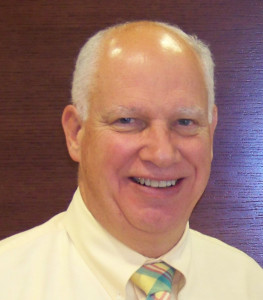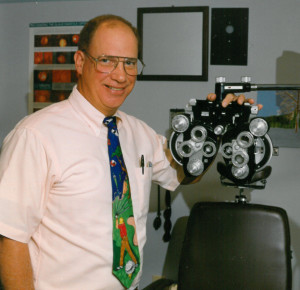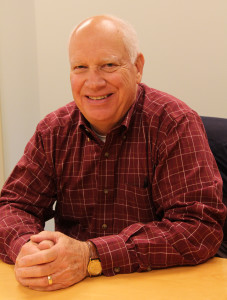Latest News
Patient Portal Brochures Available Now!
Joe Caristi joins Speare Memorial Hospital as Chief Financial Officer
Dr. Richards looks back at his career as retirement comes into focus
By Michele Hutchins, Director of Community Relations
 Dr. John Richards was only two working days into his retirement when we sat down to talk about his 37 year career as an ophthalmologist—35 of which were spent serving the eye care needs of the greater Plymouth area. He didn’t quite yet have a feel for what it means to be retired, but he was very clear on how much he loved being an ophthalmologist.
Dr. John Richards was only two working days into his retirement when we sat down to talk about his 37 year career as an ophthalmologist—35 of which were spent serving the eye care needs of the greater Plymouth area. He didn’t quite yet have a feel for what it means to be retired, but he was very clear on how much he loved being an ophthalmologist.
“I loved the general happiness of the field and that I could treat all age groups,” reflects Dr. Richards. “I loved working with my hands and the surgical side of the practice. I loved, and still do, the miracle of eye sight. The eye is one incredibly fascinating organ.”
When asked how he got interested in being an “eye doctor”, Dr. Richards says it goes back to when he was an orderly working in a hospital before he was in medical school. “I grew up at a time in medicine when physicians would invite you in because you showed interest, and there was just something about the eye that I found so intriguing.”
Like so many things, eye care has gone through a significant technological evolution of the years. By way of example Dr. Richards explains, “I was fortunate enough to experience the performing of cataract surgery four entirely different ways. Today’s procedure is phacoemulsification (or ultrasound to gradually suck out the cataract) and inserting an implant. The procedure is similar to removing the pulp of an orange leaving the orange peel intact.”
 “It is a totally different procedure from what was done originally,” he continues. “The original technique involved removing the entire cataract by opening up half the circumference of the cornea. Comparatively, today’s cataract surgery is less invasive, safer, quicker, and considered to be one of the most successful operations done on the body.”
“It is a totally different procedure from what was done originally,” he continues. “The original technique involved removing the entire cataract by opening up half the circumference of the cornea. Comparatively, today’s cataract surgery is less invasive, safer, quicker, and considered to be one of the most successful operations done on the body.”
Another example of advancements in eye care over the years is the use of lasers to treat scar tissue after cataract surgery, glaucoma and retinal diseases including bleeding, diabetic complications and wet macular degeneration. Dr. Richards says he purchased and employed three different lasers to treat patients with these conditions in his own practice. And it is only recently that the treatment for macular degeneration has evolved further to include injectable medications inside the eye to help restore vision for those specific patients.
“What has stayed the same over the years is the patient,” Dr. Richards notes. “Patients still have the same anxiety about eye conditions and health, and our role as their specialist is to reassure and get them through a particular problem and with dignity. People like to know that their doctor feels empathetic as they are going through a procedure and recovery.”
To that end Dr. Richards always worked to develop a rapport with his patients, calling them evenings or weekends following surgery just to check in; gave out his home number, so if patients had a problem after hours they could call. He even made house calls if needed, saying, “I’ve made hundreds of house calls over the years, some patients even came to my house . . . it is how it should be.”
But times and medicine do change, and Dr. Richards felt it was time for him to retire. “I haven’t skied in 15+ years, haven’t fished in three and only played one round of golf last year,” he notes. The passing of his friend and colleague Dr. Lloyd earlier this year also had a big influence on his decision to retire, “It made me stop and think.” So as he adjusts to having more time in his day to “enjoy the daily life of New Hampshire and all it has to offer,” he looks forward to hiking those 4,000 footers, getting out in his canoe, fishing, and biking, golfing and playing tennis.
But don’t think for a minute he won’t be staying on top of the latest ophthalmic advancements. Dr. Richards says he looks forward to the future developments in ophthalmology including the conquering of macular degeneration with oral medications; use of stem cells to rebuild the retina in the future; and advancements in the treatment of cataracts and glaucoma.
 Long-term, Dr. Richards says, “The biggest challenge for my field is being able to have patients have useable vision into their nineties and beyond. In 1980 I saw one patient a month in their 90s. Now it is two to three a day.”
Long-term, Dr. Richards says, “The biggest challenge for my field is being able to have patients have useable vision into their nineties and beyond. In 1980 I saw one patient a month in their 90s. Now it is two to three a day.”
For patients’ immediate eye care needs, however, Dr. Richards wants to reassure his patients that the hospital is recruiting two full-time ophthalmologists to establish themselves at White Mountain Eye Care & Optical. “Until then,” he says, “the community will be well-served by two locums, or temporary, doctors who are very qualified. Patients should feel comfortable seeing them and be assured they will provide the same range of services currently offered—big city eye care close to home.”
Need to make an appointment at White Mountain Eye Care & Optical please call (603) 536-1284.
